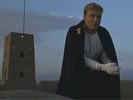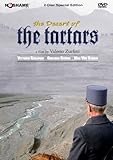Eye For Film >> Movies >> The Desert Of The Tartars (1976) Film Review
Adapted from the 1940 novel by Italian author Dino Buzzati, Desert Of The Tartars follows a young recruit of the Austro-Hungarian Imperial army as he takes up his first post at the far-flung fort of Bastiano, which overlooks a desert and a hostile mountain range (presumably in Russia). Buzzati’s text was set in an undefined period and location, but Zurlini has transported the strongly allegorical, myth-like story to 19th Century Europe without too much trouble. Competently filmed and acted and, by all accounts faithful to the novel, it’s the story itself that hinders Desert Of The Tartars as a piece of cinema.
The protagonist, Lieutenant Drogo (Jaques Perrin) is hungry for action, and is disappointed to find Bastiano a sort of sedate gentlemen’s club, where dinner is candle-lit and accompanied by a chamber orchestra, and the only fighting the officers see is a bout of fencing in the gym. Drogo finds the station stuffy and uneventful, and is determined to get out at the first opportunity.

He initially tries to obtain a transfer to a more active base, but Bastiano gradually becomes his island of the lotus-eaters – weeks, months pass and still he is unable to leave. Meanwhile, secrets, mysteries and doubts gradually surface, the most pressing of which the ghostly white horses and riders who often come into view not far from the fort. Drogo’s concern is met with a wall of stubborn denial from his superiors, who refuse to investigate further.
Crumbs of plot are dropped here and there, which seem to suggest narrative payoffs and resolutions to the puzzling questions that arise, but it’s all a smokescreen. The great disappointment of Desert Of The Tartars is that nothing much happens over the two hours and 20 minutes to bolster the unsettling atmosphere that is very successfully created. The characters remain flat and don’t evolve significantly (the fact that they’re almost indistinguishable in their uniforms doesn’t help) and the Kafkaesque treatment of the Imperial army’s nightmarish, surreal bureaucracy also comes to little in the end.
The elements of the film that most stand out are the haunting panoramas of the grey desert and the curious abandoned settlement that surrounds the fort. Shot almost entirely at the ancient fortress-city of Arg-é Bam, in southern Iran, the location is the real star of the film, but then it could have been showcased better in a National Geographic special and saved us some tears of boredom at the same time.
Essentially, Desert Of The Tartars is intended to be a poignant essay on humans’ absence of control over their own destiny, but it didn’t resonate with me. It ends up being a monotonous, pessimistic and long-winded way of expressing what John Lennon summed up more pithily a few years later: “Life is what happens to you while you’re busy making other plans”.
Reviewed on: 05 Mar 2009


















